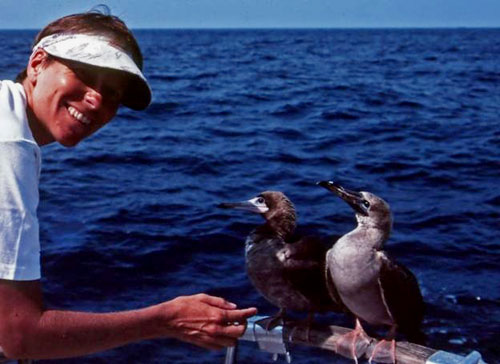Published in the Ocean Watch column, Honolulu Star-Advertiser © Susan Scott
June 7, 2010
Years ago, two immature red-footed boobies landed on the aft rail of my sailboat, Honu, which at the time was more than 1,000 miles offshore and rolling in heavy seas. The young seabirds stood there calmly for more than 48 hours, grooming their feathers by day, sleeping next to each other at night and occasionally squabbling for rail space. By the time those two feathered friends took off, I’d fallen in love.

I was reminded of that remarkable visit last week when on a pre-sunrise walk on Lanikai Beach, a squadron of seven red-footed boobies glided over my head. They looked like a pack of professional bicycle racers, each drafting the individual ahead.
These were mature boobies in their spring finery, body feathers velvet white, wings tipped in black, beaks blue with pink and orange liner. The birds flew so low, I could see their red webbed feet folded for flight and tucked tight against their bodies.
Another group of red-foots flew by, then another and another. Soon the area was bursting with boobies presumably from their colony at Ulupau Head (the tip of the Kaneohe Marine Corps station). Some birds skimmed the water’s surface, others soared high in formation and a few rode the blustery tradewinds alone. All were heading off to work.
A day’s work for red-footed booby birds (and the world’s other five species) is diving for fish. This is a spectacle to behold. A booby can spot a fish from nearly 100 feet high, tuck its body into torpedo shape and plunge into the water with barely a splash.
If the fish disappears, the booby can abort its dive only a wing’s length from the surface. And if the fish darts down, the bird can pursue it to 15 feet deep by swimming with its big webbed feet.
Flying fish and flying squid are about a quarter of a red-foot’s diet because this species is good at catching creatures on the fly. Also, red-footed boobies have larger eyes than the other boobies, enabling them to hunt in dim light when squids rise to the surface. Red-footed boobies are famous for being out fishing before the crack of dawn, and are the last return to a seabird colony in the evening.
Hawaii hosts three species of booby birds — masked, brown and red-footed — all a bit bigger than a mallard duck. And even though boobies evolved with no land predators as have Hawaii’s albatrosses, monk seals and sea turtles, the chicks can be a challenge to catch. I have fastened ID bands on the legs of all three of Hawaii’s boobies, and the little darlings are an armful of scratching toenails, flapping wings, sharp beaks and gooey guano.
The startled chicks don’t mean any harm, though, and normally are friendly as puppies. When red-footed boobies begin flying, they practice landing on objects such as boat railings, tree branches or human heads. I once watched my friend Alex walk the half-mile length of Tern Island wearing a red-footed booby chick for a hat.
It was 22 years ago that I wrote a column about the two red-foots hitching a ride on Honu’s rail, and an editor gave it the headline “Boobies win the hearts of lonely sailors.” That caused some chuckling in the newsroom (and a less interesting headline in later editions), but the sentiment was right. This sailor’s heart belongs to boobies.